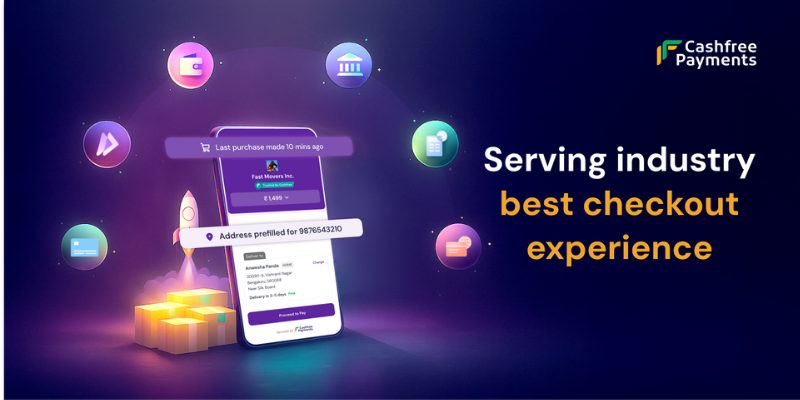
India’s internet economy has unlocked unprecedented growth for online-led businesses, ranging from D2C brands to digital retailers and social commerce platforms. With a surge in mobile users, improved digital infrastructure, and rising comfort with online payments, the online commerce ecosystem is flourishing.
With projections estimating India’s ecommerce market to touch over US$ 345 billion by FY30, the opportunity has never been bigger.
Yet, as brands scramble to scale across social commerce, influencer marketing, and last-mile logistics, there’s one high-intent moment that continues to be criminally overlooked: the checkout funnel.
And it’s costing businesses big.
A funnel where 70% of revenue is lost
While acquisition costs rise and attention spans drop, the checkout experience – the very last step of the funnel – remains unoptimised for many digital brands. The result? A staggering 70% cart abandonment rate.
That’s not just a stat. That’s a direct hit on your top line.
Think of it this way: you’ve invested lakhs in building brand awareness, running performance ads, and nurturing customers to the point of purchase. But if your checkout flow creates friction, whether it’s slow loading, limited payment options, or clunky user interfaces, you’re essentially locking the store just as customers reach the billing counter.
Checkout isn’t just a backend function; it’s an invisible growth lever. A seamless, frictionless checkout experience can directly drive higher conversion rates, improved customer retention, and lower customer acquisition costs. Therefore, founders and growth leaders must treat checkout not as an afterthought, but as a core business metric.
Checkout flaws and how to fix them
Here’s a closer look at what typically goes wrong, and how smart infrastructure can solve it.
Limited payment options
In today’s hyper-competitive ecommerce and D2C landscape, payment flexibility and experience are critical to driving conversions. Shoppers now expect not just a wide range of payment options—be it UPI, credit/debit cards, net banking, BNPL, or EMI plans—but also a frictionless checkout journey. When brands fail to deliver on these expectations, it creates friction at the most crucial stage of the funnel—checkout—leading to higher cart abandonment and lost revenue. With fintech giants like Cashfree Payments, internet-first businesses needn’t worry about this. Supporting over 120 payment modes along with a seamless, optimised payment experience, Cashfree helps brands ensure every shopper finds their preferred and most convenient way to pay. Further, Cashfree offers features like one-click payments, bottom-sheet UPI flows, and CVV-less transactions, designed to reduce friction, build trust and boost repeat purchases.
Low trust for new brands
First impressions matter, especially for newer D2C brands trying to break into crowded markets. Even when customers are interested in the product, hesitation creeps in at the point of purchase. The lack of visible signals of trust such as customer reviews, brand popularity, or purchase activity, can lead to drop-offs even after a customer has spent time browsing. To counter this, Cashfree has a built-in social proof (e.g., “1L+ orders served” or real-time indicators like “Last order placed 1 minute ago”) at checkout to reinforce credibility. For emerging brands, this means reinforcing trust at the point of conversion.
Cash-on-Delivery (COD) preference & RTO risk
Despite the rise of digital payments, Cash on Delivery (COD) remains a preferred choice, especially among first-time or hesitant buyers wary of online transactions. However, for brands, COD often brings high Return-to-Origin (RTO) rates and inflated logistics costs. Each unfulfilled order not only erodes margins but also disrupts inventory and fulfillment workflows. Cashfree Payments’ checkout suite helps brands tackle this challenge with intelligent COD solutions. Through partial COD, customers pay a small upfront amount, indicating genuine purchase intent. Coupled with risk-verified COD, which leverages data signals to assess the likelihood of delivery success, brands can significantly lower RTO risks while preserving customer trust and flexibility.
Lack of dynamic offers
Online shoppers expect deals and offers. In fact, for many customers, the presence (or absence) of a visible discount can make or break a buying decision. A static, uninspiring checkout flow that fails to offer timely promotions can lead to exits, even if the product is great. With Cashfree, brands can dynamically configure personalized discounts, cashbacks, or free gifts within the checkout flow. This helps convert low-intent browsers into paying customers.
Tedious checkout inputs
Nothing kills an impulse purchase faster than a long, tedious checkout form. From manually entering shipping details to selecting payment options from scratch, each additional step introduces friction; and friction causes drop-offs. This is especially damaging for mobile-first users who demand speed and simplicity. Cashfree tackles this head-on with intelligent pre-fills for addresses, preferred payment methods, and one-click mobile login, streamlining the experience for both returning and first-time buyers.
Why it matters more than ever in 2025
In 2025, convenience is currency. Consumers expect speed, transparency, and personalisation; not just during discovery but at every step of the journey, especially during conversion. And that’s where many brands lose the plot.
The battleground is no longer just about who gets discovered first but also about who converts better. Brands that solve for checkout now will see immediate boosts in revenue, build trust that leads to repeat purchases, and achieve better ROI on marketing spends by reducing CAC.
Make checkout your secret growth lever
You’ve done the hard work of acquiring the customer. Don’t lose them at the final mile.
Checkout is no longer just about payments. It’s your conversion engine, trust builder, and growth accelerator; all rolled into one.
Treating checkout as a strategic priority can unlock serious growth – from better margins to stronger customer relationships. With platforms like Cashfree Payments’ Checkout Suite, internet-first brands can stop reinventing the wheel and start converting intent into revenue, seamlessly.

